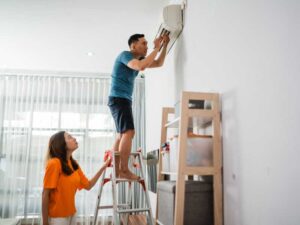Ever walked into a room and immediately felt the air was stale? That’s a telltale sign of poor ventilation, a common issue in many indoor environments that can seriously affect your health, comfort, and even the integrity of buildings. Poor ventilation means there’s not enough fresh outdoor air coming in to replace the indoor air, which can lead to a buildup of pollutants like carbon dioxide, volatile organic compounds (VOCs), and particulate matter.
These aren’t just fancy science terms; they’re real threats that can cause everything from headaches to serious respiratory problems. But don’t worry, there are ways to fix it, from improving natural airflow to upgrading your HVAC systems. Stick around as we dive into what causes poor ventilation, why it’s a problem, and how you can breathe easily again with the right solutions.
Poor Ventilation Refers to Inadequate Air Exchange

Poor ventilation, characterized by insufficient air exchange, can significantly impact indoor environments, leading to a range of adverse effects on health, comfort, and building integrity. This condition occurs when the flow of fresh outdoor air into space is inadequate to remove indoor pollutants and maintain high air quality. The most important goal of addressing poor ventilation is to ensure a healthy, safe, and comfortable environment for occupants by facilitating adequate air exchange.
Inadequate ventilation can lead to the accumulation of pollutants such as carbon dioxide, volatile organic compounds (VOCs), and particulate matter, which can cause health issues ranging from headaches and dizziness to respiratory problems and exacerbated asthma symptoms. Furthermore, it can contribute to the development of mold and mildew, which not only damages building materials but can also lead to serious health problems. Understanding the significance of proper ventilation involves recognizing its role in diluting and removing indoor airborne contaminants.
Effective ventilation systems are designed to balance the need for energy efficiency with the necessity of maintaining indoor air quality. They achieve this by regulating air flow, filtering incoming air, and managing humidity levels to create a healthy and comfortable indoor environment. Addressing poor ventilation requires a comprehensive approach that may include enhancing natural ventilation, upgrading HVAC systems, and incorporating air cleaning technologies.
By prioritizing adequate air exchange, building owners and occupants can significantly improve indoor air quality, thereby safeguarding health and enhancing the overall indoor experience.
Leads to Stale, Unhealthy Indoor Environments
Poor ventilation, marked by inadequate air exchange, is a primary cause of stale, unhealthy indoor environments. This situation fosters the accumulation of indoor pollutants such as carbon dioxide, volatile organic compounds (VOCs), and particulate matter. These contaminants are associated with a spectrum of health issues, ranging from minor symptoms like headaches and dizziness to more severe conditions such as respiratory problems and exacerbated asthma symptoms.
Additionally, the absence of fresh air circulation can lead to the growth of mold and mildew, posing further health risks to occupants and threatening the structural integrity of buildings. To combat these issues, addressing poor ventilation is essential for maintaining a healthy, safe, and comfortable indoor environment. Effective measures include enhancing natural ventilation, upgrading HVAC systems to improve air filtration and circulation, and incorporating air cleaning technologies.
By focusing on ensuring adequate air exchange, it is possible to significantly enhance indoor air quality, effectively preventing the emergence of stale, unhealthy indoor environments and safeguarding occupant well-being.
Causes of Poor Ventilation

Several factors contribute to poor ventilation, leading to stale and unhealthy indoor environments. Inadequate air vents in design limit the flow of fresh air into and out of a building, trapping pollutants indoors. Blocked air pathways, caused by furniture placement or debris, further restrict air movement, exacerbating the problem.
Additionally, overuse of air-tight insulation, while beneficial for energy efficiency, can hinder proper ventilation if not paired with adequate venting solutions. Addressing these causes is essential for improving air quality and ensuring a healthy indoor environment.
Inadequate Air Vents in Design
Inadequate air vents significantly hinder effective ventilation. Buildings with insufficiently designed vents, or those that have too few vents, struggle to facilitate proper air exchange. This leads to the accumulation of pollutants and results in a stale indoor atmosphere.
Blocked Air Pathways by Furniture or Debris
Blocked air pathways are a major obstacle to maintaining a healthy indoor environment. When airflow is obstructed by furniture or debris, it prevents the efficient circulation of fresh air, trapping stale air and pollutants inside the space.
Overuse of Air-Tight Insulation, Lacking Vents
The overuse of air-tight insulation without adequate ventilation measures can severely impact indoor air quality. While such insulation is key for reducing energy consumption, it can also trap pollutants and moisture inside if not balanced with proper ventilation, leading to poor air quality and discomfort.
Consequences of Poor Ventilation

Poor ventilation leads to several negative outcomes, significantly impacting health and the environment. The accumulation of indoor pollutants, such as carbon dioxide (CO2), volatile organic compounds (VOCs), and particulate matter, poses significant health risks. These can range from minor irritations, like headaches and dizziness, to serious conditions, including asthma, allergies, and respiratory issues.
Additionally, poor ventilation contributes to increased humidity levels, creating an ideal environment for mold growth. This not only affects air quality but can also damage building materials and furnishings. Addressing ventilation issues is crucial for preventing these consequences and ensuring a safe, healthy indoor environment.
Accumulation of Indoor Pollutants, e.g., CO2, VOCs
The accumulation of indoor pollutants, such as carbon dioxide (CO2) and volatile organic compounds (VOCs), is a significant consequence of poor ventilation. This buildup compromises air quality and can lead to a variety of health concerns.
Increased Humidity, Promoting Mold Growth
Increased humidity, another byproduct of inadequate ventilation, fosters conditions perfect for mold growth. Mold not only poses health risks but also causes damage to building structures and interiors.
Health Issues: Asthma, Allergies, Headaches
Poor ventilation is directly linked to a spectrum of health issues, including asthma, allergies, and headaches. These health problems often arise from the presence of pollutants and mold, which flourish in environments lacking proper air exchange.
How to Identify Poor Ventilation

Identifying poor ventilation involves recognizing key signs that indicate inadequate air exchange. Persistent unpleasant odors and a lack of freshness in the air are clear indicators of poor ventilation. Additionally, visible mold growth on walls and ceilings points to high humidity levels, often a result of insufficient ventilation.
Another sign is condensation on windows, which signals excessive indoor moisture and highlights the need for improved air circulation. Recognizing these signs is crucial for taking timely action to address ventilation issues and ensure a healthy indoor environment.
Persistent Unpleasant Odors, Lack of Freshness
Persistent unpleasant odors and a noticeable lack of freshness in the air are significant indicators of poor ventilation. These conditions suggest that indoor air is not being effectively exchanged with fresh, outdoor air.
Visible Mold Growth on Walls, Ceilings
Visible mold growth on walls and ceilings signals high humidity levels, a common consequence of inadequate ventilation. Mold not only poses health risks but also compromises the structural integrity of buildings.
Condensation on Windows, Indicating High Humidity
Condensation on windows is a clear sign of high indoor humidity, indicative of poor ventilation. This condition fosters mold growth and can significantly degrade indoor air quality.
Solutions for Poor Ventilation
Addressing poor ventilation requires a multifaceted approach to ensure a healthy indoor environment. Installing mechanical ventilation systems, such as HRV (Heat Recovery Ventilators) or ERV (Energy Recovery Ventilators), can significantly improve air exchange. Exhaust fans in kitchens and bathrooms are effective in removing moisture and odors, reducing the risk of mold growth.
Regularly opening windows facilitates natural air exchange, introducing fresh air while expelling stale indoor air. Furthermore, incorporating air-purifying plants, like spider plants, can enhance air quality by removing pollutants. Together, these solutions can effectively mitigate the issues caused by poor ventilation, promoting a healthier and more comfortable indoor atmosphere.
Installing Mechanical Ventilation, Like HRV or ERV Systems
Installing mechanical ventilation systems, such as HRV (Heat Recovery Ventilators) or ERV (Energy Recovery Ventilators), significantly enhances indoor air quality. These systems are designed to efficiently exchange stale indoor air with fresh outdoor air, ensuring a balanced and healthy environment.
Exhaust Fans in Kitchens, Bathrooms to Remove Moisture
Utilizing exhaust fans in kitchens and bathrooms is crucial for removing excess moisture and odors. This strategy is effective in mitigating mold growth and maintaining a healthy indoor environment.
Regularly Opening Windows for Natural Air Exchange
Regularly opening windows is a simple yet effective method for promoting natural air exchange. This practice allows for the expulsion of stale air and the introduction of fresh, outdoor air, significantly improving indoor air quality.
Incorporating Plants That Purify Air, e.g., Spider Plants
Incorporating air-purifying plants, such as spider plants, into indoor spaces not only beautifies the environment but also enhances air quality. These plants are known for their ability to filter out pollutants, contributing to a cleaner, healthier indoor atmosphere.
Improve Ventilation with Callidus Air
Improving ventilation is crucial for maintaining a healthy indoor environment, and Callidus Air is dedicated to providing effective solutions. With a focus on advanced ventilation systems, such as HRV and ERV, Callidus Air ensures optimal air exchange, reducing indoor pollutants and enhancing air quality. The use of strategically placed exhaust fans in areas prone to moisture, like kitchens and bathrooms, further aids in preventing mold growth and maintaining a fresh indoor atmosphere.
Encouraging regular window openings for natural air exchange and recommending the incorporation of air-purifying plants are part of Callidus Air’s holistic approach to improving indoor air quality. Trust Callidus Air to transform your indoor spaces into healthier, more comfortable environments.
Final Thoughts
Ensuring proper ventilation within indoor spaces is essential for promoting a healthy, comfortable living and working environment. Addressing poor ventilation through measures such as installing advanced ventilation systems, utilizing exhaust fans, encouraging natural air exchange, and incorporating air-purifying plants can significantly improve air quality. As we’ve explored, the consequences of neglecting ventilation can be dire, affecting both health and building integrity.
By taking proactive steps and considering solutions like those offered by Callidus Air, individuals, and businesses can effectively mitigate these risks, ensuring spaces are not only safer but also more pleasant to inhabit. Emphasizing the importance of good ventilation is key to fostering well-being and comfort in any indoor setting.

